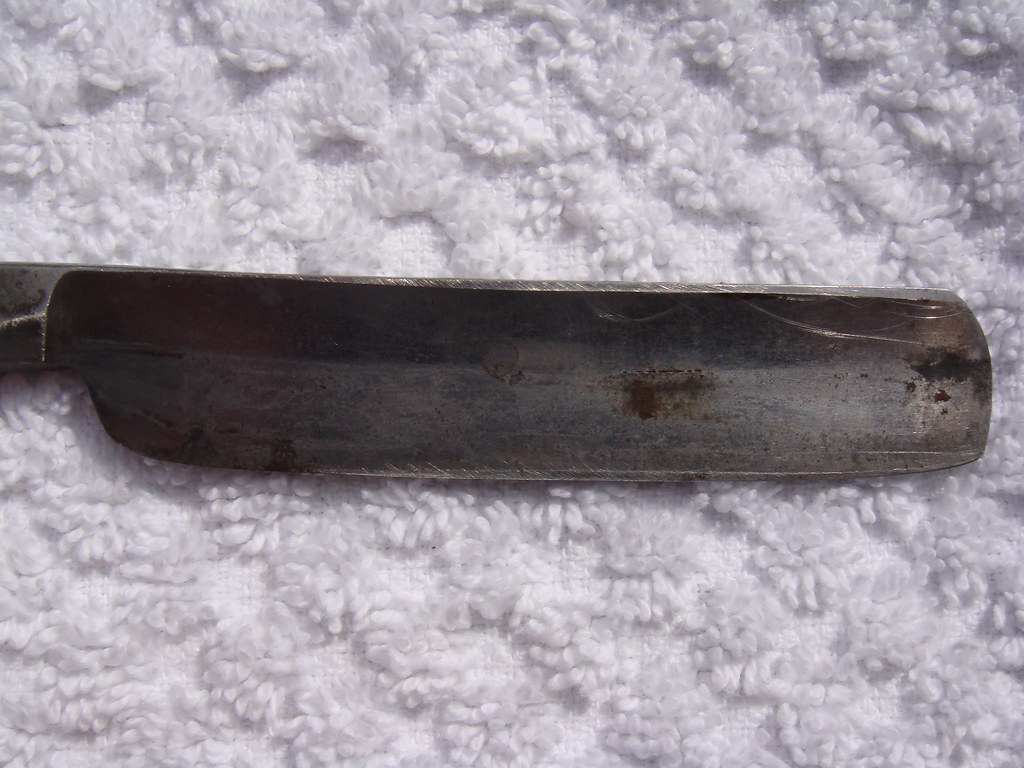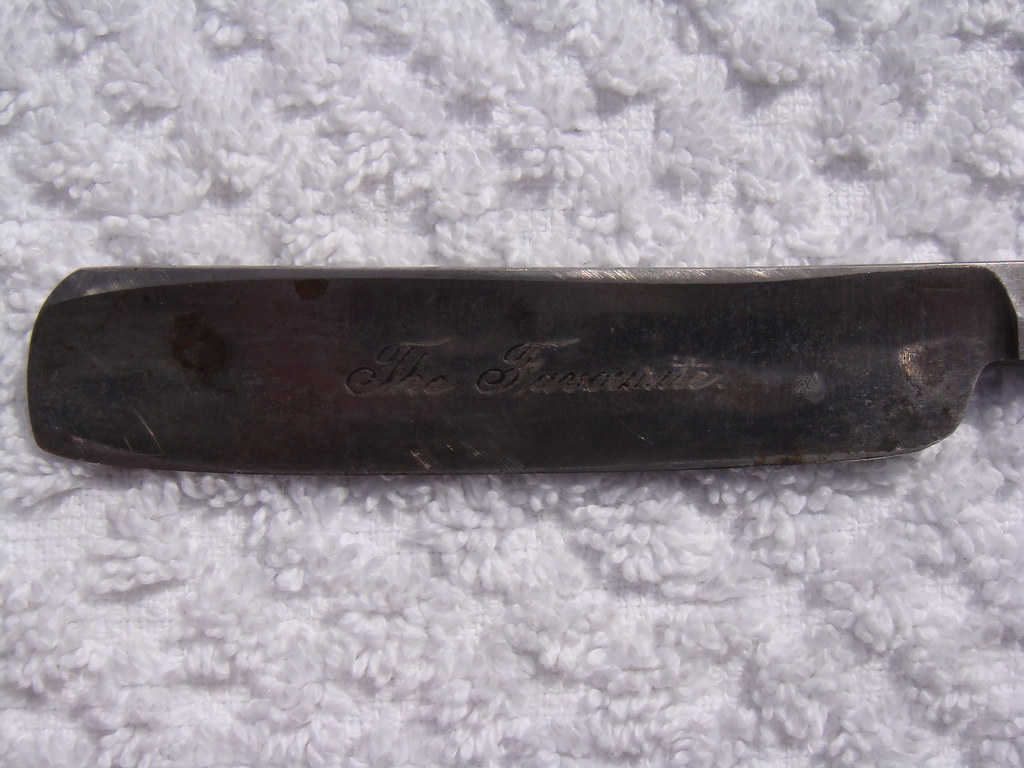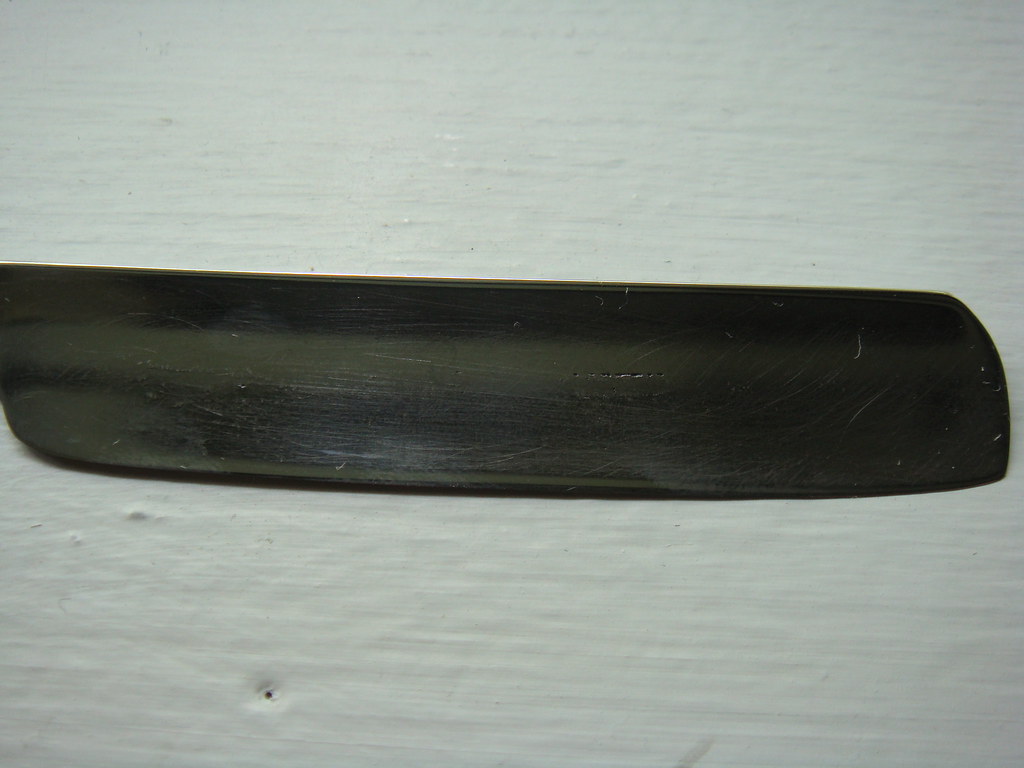Results 1 to 10 of 11
Thread: First try at cleaning up a blade
-
04-27-2010, 09:08 PM #1
 First try at cleaning up a blade
First try at cleaning up a blade
Here's my first attempt at cleaning up the blade of a razor I bought from an antique store.
Here's the before:


Here's the after my first try:


I definitely didn't do as good of a job as the experts on here, no need to say. I think I must have gone up in grit too quickly which is why you can see scratches still.
I think I must have gone up in grit too quickly which is why you can see scratches still.
I started at 320, and tried to get all of the pitting out, while trying to avoid the markings. Then I went up to 400, 600, 800, 1000, 1500 and 2000. Then I finished with Mother's metal polish.
I think I probably should have spent more time in the 600/800 range. :|
Should I go back to that range and spend more time then work up again? Or is the potential damage to the blade not worth it? I'm sure I could get a nice shaver out of it even if it's scratchy. Since only I would use it I guess it's only me that would have to care whether it's scratched up heh.
-
04-28-2010, 04:32 AM #2

Great job.If like it the way it is leave it.It will shave just fine after a good honing.

-
The Following User Says Thank You to Blackstangal For This Useful Post:
RobertH (04-28-2010)
-
04-28-2010, 04:47 AM #3
-
The Following User Says Thank You to niftyshaving For This Useful Post:
RobertH (04-28-2010)
-
04-28-2010, 01:58 PM #4aka shooter74743




- Join Date
- Sep 2009
- Location
- SE Oklahoma/NE Texas
- Posts
- 7,285
- Blog Entries
- 4
Thanked: 1936
I'd say use it as well. Getting the scratches from the previous grit is tough. I read on one of the threads somewhere that adding rubbing compound to your sandpaper will help to keep the gouges of the coarser paper down. I haven't tried it, but it couldn't hurt.
Southeastern Oklahoma/Northeastern Texas helper. Please don't hesitate to contact me.
Thank you and God Bless, Scott
-
04-28-2010, 04:08 PM #5

What are some name brands for rubbing compound that are good for razors?
-
04-28-2010, 04:23 PM #6At this point in time...




- Join Date
- Jun 2007
- Location
- North Idaho Redoubt
- Posts
- 27,157
- Blog Entries
- 1
Thanked: 13249
The real work when hand-sanding is at the lowest grit you start at...
Adding an oil (3n1, WD-40) after dry sanding on each grit, will make a huge difference in the final outcome...
You have to go low enough so that all the scratches are gone and the finish at that level is uniform then and only then move up in grit....
BTW you have a good start going on this one, only you can decide when enough is enough
-
04-28-2010, 04:39 PM #7

How about camelia oil which I have?
-
04-28-2010, 05:00 PM #8At this point in time...




- Join Date
- Jun 2007
- Location
- North Idaho Redoubt
- Posts
- 27,157
- Blog Entries
- 1
Thanked: 13249
IDK I have never tried it in that capacity, I don't see why not, honestly the objective is to create a slurry with the sandpaper, which you can even do with plain water, but the oils help the process more so...I am always hesitant to say try something that I haven't actually tried myself and proved, I know WD-40 and 3-n-1 oil work...
-
The Following User Says Thank You to gssixgun For This Useful Post:
RobertH (04-28-2010)
-
04-28-2010, 05:10 PM #9

I would go with Glen's recommendation. I think that Camelia Oil is rather expensive--in relation to WD-40 or 3 in 1 oil--for the restoration work you will be using it for.
I have never done so, but I asume that you will need more than just a few drops for this process."Age is an issue of mind over matter. If you don't mind, it doesn't matter." Mark Twain
-
04-28-2010, 07:21 PM #10

Great start! I hate hand sanding & can appreciate the work that goes in to it.
My tip would be to keep the pressure fairly light. That can help prevent any rogue deeper scratches.
Keep it up!


 LinkBack URL
LinkBack URL About LinkBacks
About LinkBacks






 Reply With Quote
Reply With Quote

